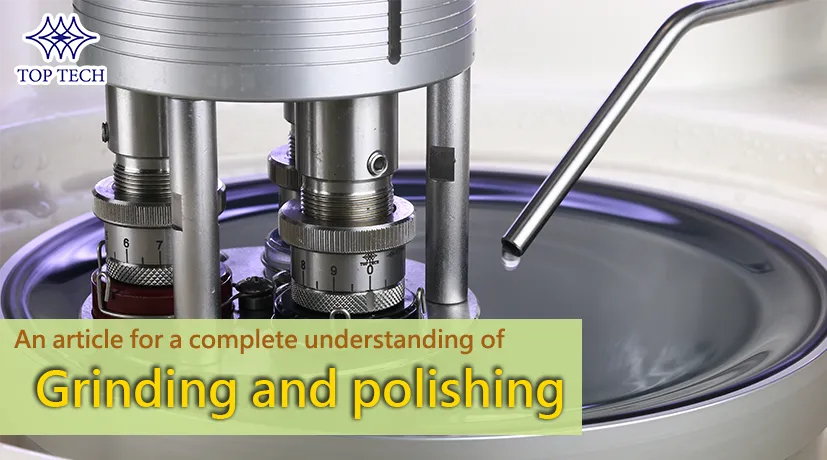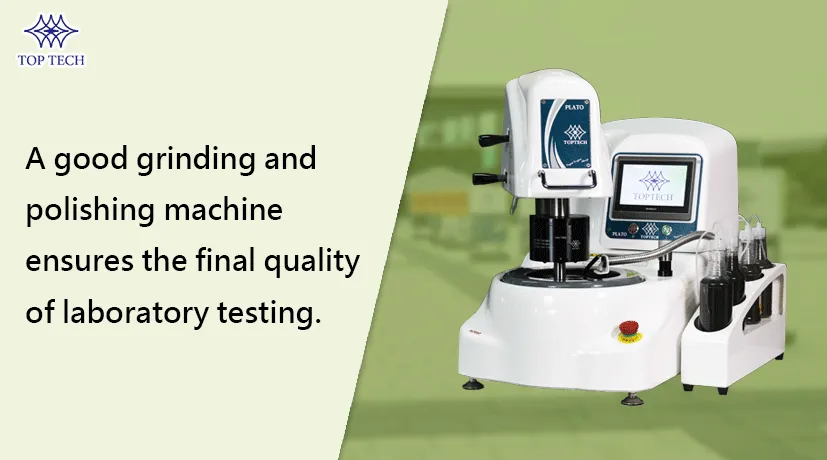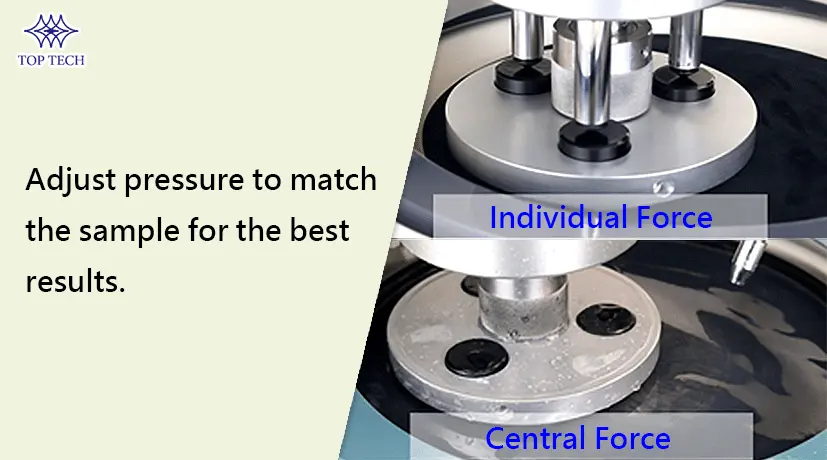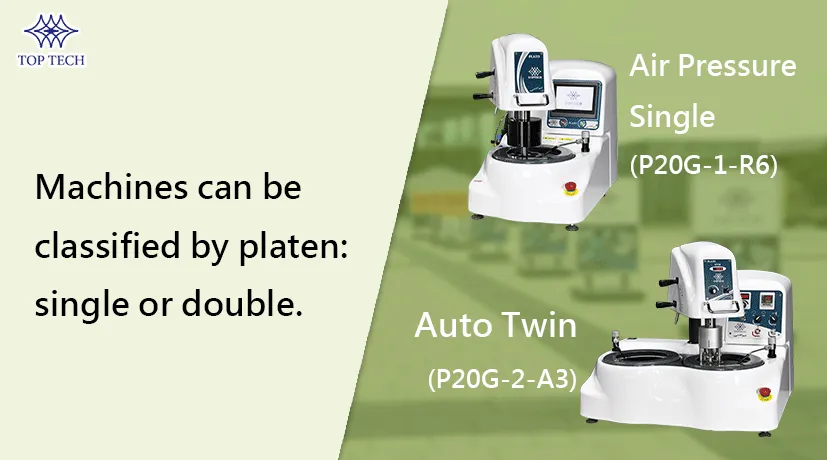
- Note 1. Purpose and Function of Metallographic Grinding and Polishing
- Note 2. Choosing a Metallographic Grinding and Polishing Machine
- Note 3. Types of Metallographic Grinding and Polishing Machines
- Note 4. Understanding Metallographic Grinding and Polishing Consumables
- Note 5. Cost Analysis Before and After Purchasing Metallographic Grinding and Polishing Machines
- Principle 1: The goal is to achieve a highly reflective surface on the sample before material testing, facilitating subsequent analysis.
- Principle 2: When choosing metallographic grinding and polishing machines, it is essential to consider factors such as material hardness, inspection requirements, work efficiency, and long-term usage costs.
- Principle 3: Machines can be classified by platen: single or double, and by operation mode: manual or automatic.
- Principle 4: Grinding can be performed using diamond grinding discs or silicon carbide grinding papers, while polishing involves the use of polishing cloths with diamond suspension or aluminum oxide powder.
- Principle 5: When making purchasing decisions, factors like costs, consumables, maintenance, hidden risks, and return on investment should be taken into account to make an informed decision.
Note 1. Purpose and Function of Metallographic Grinding and Polishing
Basic Concepts of Metallographic Grinding and Polishing
Metallographic grinding and polishing is a critical sample preparation technique in material science. Its primary purpose is to prepare the sample surface to meet the requirements for microscopic observation, thereby enhancing the quality of inspection results.
This process usually involves multiple steps, from rough grinding to fine grinding, and finally to polishing, gradually eliminating surface roughness until a highly reflective surface is achieved, allowing the internal structure of the sample to be clearly presented under a microscope.
In modern laboratories, metallographic grinding and polishing machines have become indispensable equipment for enhancing quality control. These machines are not only used for the analysis of metal materials but are also applied in the quality inspection of ceramics, semiconductor materials, and other materials.
Through precise grinding and polishing, it is possible to accurately observe the microstructure of samples, thereby providing reliable data support for research and development.
The purpose of grinding is to remove mechanical damage layers and scratches on the sample surface, making it smooth and flat. This process is essential for revealing internal grain structures, phase changes, inclusions, and other microstructural features of the material.
Polishing further removes minor scratches left from grinding, eliminating any irregularities on the sample surface, ensuring that the sample can be presented clearly and without interference under microscopic observation.
Detailed Steps of Metallographic Grinding and Polishing
The metallographic grinding and polishing process typically includes the following main steps, each serving a specific purpose to ensure that the sample provides reliable data for final inspection.
1. Rough Grinding:
This is the first step of grinding, aimed at removing the surface damage layer left from the metallographic sectioning process. This step usually uses coarse-grit silicon carbide grinding papers or diamond grinding discs.
The focus of rough grinding is to quickly remove material, allowing for subsequent fine grinding stages. It is typically performed using specialized metallographic grinding equipment. Automatic grinding and polishing machines can provide stable grinding speed and pressure to ensure sample consistency.
2. Fine Grinding:
Fine grinding is the last grinding step, using very fine-grit silicon carbide grinding papers to further eliminate scratches caused by rough and medium grinding. This process is critical for ensuring the sample's flawless presentation under the microscope and significantly impacts the final quality inspection of the sample.
3. Polishing:
Polishing is the final step, used to remove the minor scratches left from fine grinding and achieve a highly reflective surface.
Polishing cloths and polishing suspension or aluminum oxide powder are typically used to complete this stage. This step is crucial for the accuracy of inspection results as it provides a highly reflective sample that can be analyzed.
In the metallographic laboratory, every detail of the polishing process needs to be strictly monitored to ensure that the final sample quality meets the required standards.

Note 2. Choosing a Metallographic Grinding and Polishing Machine
Basic Principles for Selecting a Metallographic Grinding and Polishing Machine
Choosing the right metallographic grinding and polishing machine involves multiple considerations, including the sample's material, hardness, and the laboratory's workload. It is crucial to select laboratory equipment with corresponding functions and performance based on these requirements.
1. Material and Hardness:
Different materials have varying requirements for metallographic grinding and polishing.
For harder materials, such as tungsten and ceramics, it is recommended to use diamond grinding discs, as they provide a higher removal rate.
For softer materials, such as copper and aluminum alloys, silicon carbide grinding papers may be more suitable.
Laboratory technicians select appropriate metallographic grinding and polishing machines and consumables according to the needs of different samples to ensure the quality and precision of each sample.
2. Laboratory Workload:
If the laboratory frequently handles a large number of samples, automatic grinding and polishing machines, as well as dual platen grinding and polishing machines, are excellent choices.
Automatic grinding and polishing machines can maintain stable speed and pressure, handle multiple samples simultaneously, and ensure consistency in sample preparation.
Dual platen grinding and polishing machines are equipped with two platens, allowing simultaneous grinding or polishing.

3. Pressure Adjustment:
Selecting models with adjustable pressure is crucial. Excessive pressure may damage the sample, while insufficient pressure will not achieve effective grinding.
Pressure is typically adjusted based on the sample's characteristics to ensure optimal processing results. Therefore, metallographic equipment that can precisely adjust pressure is more adaptable to different sample requirements.
4. Platen and Head Rotation Speed Settings:
Different materials require different platen and head rotation speeds. Higher speeds are suitable for harder materials, while lower speeds are suitable for softer materials.
Equipment with flexible adjustment of these parameters can maximize sample preparation quality and ensure consistency and accuracy in grinding and polishing results.
Selection Strategies for Laboratory Equipment in Different Scenarios
Choosing a metallographic grinding and polishing machine is not just about selecting a powerful piece of laboratory equipment. It also requires considering specific applications for different scenarios. The requirements in metallographic laboratory environments may vary across different industries, so it is essential to consider the adaptability and flexibility of metallographic equipment.
1. Research and Educational Purposes:
For research institutions and educational institutions, it is usually necessary to handle various materials with varying sample quantities.
These applications require selecting laboratory equipment with high flexibility and ease of operation, especially models suitable for handling a wide range of samples.
Research laboratories often choose multifunctional metallographic grinding and polishing machines to accommodate different types of research needs while ensuring the durability and ease of use of the equipment.
2. Industrial Applications:
In industrial applications, it is typically necessary to handle a large number of standardized samples. These samples usually have consistent material properties and shapes, making it more important to select high-efficiency, high-output laboratory equipment that can quickly process large batches of samples while ensuring their quality consistency.
For example, dual platen grinding machines can process multiple samples simultaneously, greatly improving production efficiency. In industrial metallographic laboratories, this type of equipment is commonly used for quality inspection and failure analysis to ensure product consistency and reliability.
3. Precision Material Analysis and Semiconductor Industry:
For laboratories that require precision material analysis, especially in the semiconductor industry, it is crucial to select equipment that can provide highly reflective and analyzable samples.
The metallographic laboratory equipment typically features advanced control systems that can precisely control every parameter of grinding and polishing, achieving optimal analysis results and ensuring the quality and stability of semiconductor materials during the manufacturing process.
In semiconductor metallographic laboratories, the stability and precision of the laboratory equipment is crucial for the final product quality.
Considerations When Choosing Laboratory Equipment
When selecting a metallographic grinding and polishing machine, several key considerations need to be carefully evaluated. These considerations not only affect the initial choice of equipment but also its long-term operational effectiveness.
1. Long-term Operating Costs:
In addition to the initial purchase cost of the equipment, it is essential to consider the long-term operating costs, including maintenance and consumable replacement. Choosing laboratory equipment with high durability and low consumable costs can save a substantial amount of expenses over long-term use.
2. After-sales Service and Technical Support:
When purchasing equipment, it is important to ensure that the supplier can provide good after-sales service and technical support. This is critical for the operational stability and quality of the equipment, including installation, training, maintenance, and troubleshooting services.
When procuring metallographic grinding and polishing machines, it is common to work with suppliers who can offer comprehensive technical support and prompt response. This ensures that any issues with the equipment can be resolved quickly, preventing disruptions to the experiment schedule.
▉▎Further reading: Understanding of metallographic grinding and polishing machines - detailed types and functional specifications.
Contact Us / Inquiry
Note 3. Types of Metallographic Grinding and Polishing Machines
Metallographic grinding and polishing machines are essential laboratory equipment in various fields such as material science, metallurgy, and electronics. Selecting the appropriate grinding and polishing machine based on different inspection requirements and sample characteristics not only improves work efficiency but also ensures the quality of inspection and the accuracy of analysis results. The following section will explore their applications and selection considerations based on manual and automatic grinding and polishing machines, single and dual platen configurations, and pressure application methods.
Manual and Automatic Grinding and Polishing Machines
Metallographic grinding and polishing machines play a crucial role in laboratories and industrial production. Depending on different application needs, users can choose between manual or automatic grinding and polishing machines. These two types of laboratory equipment have distinct features and are suitable for different sample preparation requirements. Manual grinding and polishing machines excel in flexibility and cost-effectiveness, making them ideal for small-batch or single-sample processing. On the other hand, automatic grinding and polishing machines enhance processing speed and ensure consistency in quality through efficient automated functions, especially suitable for large-batch sample processing and quality control. The following sections provide a detailed introduction to the features and application scenarios of manual and automatic grinding and polishing machines.
1. Manual Grinding and Polishing Machines
Manual grinding and polishing machines have various applications and are particularly suitable for low-frequency sample preparation and irregular sample shapes. The main features and challenges of manual grinding and polishing machines are as follows:
(1)High Flexibility
Manual grinding and polishing machines allow operators to make immediate adjustments according to the specific requirements of the sample, which is especially important when grinding and polishing samples of different materials and shapes.
(2)Cost-effectiveness
For laboratories with low usage frequency, manual grinding and polishing machines are a high-value option without the need for investment in expensive automated equipment.
(3)Dependence on Operator Experience and Skills
The quality of manual operation largely depends on the operator's experience and skills, which may lead to inconsistencies between different operators.
(4)Time-consuming and Labor-intensive
The manual grinding and polishing process usually requires a long time and significant labor, making it unsuitable for applications that require high efficiency and quality.
(5)Not Suitable for Large-scale Samples
In large-scale sample inspection, manual operations may result in inconsistencies and lower efficiency.
▉▎Further reading: Learn more about manual grinding and polishing machines (Air Pressure_Single)P20G/P25G-1R6 and (Air Pressure_Twin) P20G/P25G-2-R6 and their functional differences.
2. Automatic Grinding and Polishing Machines
Automatic grinding and polishing machines play a critical role in sample preparation, especially when handling a large number of samples.
The definition of automation is broad and generally refers to the mechanization of grinding and polishing processes, also known as "automated sample preparation." Operators still need to manually replace consumables, place samples, and clean materials during grinding and polishing. However, due to rising labor costs, fully automated laboratory equipment has also emerged.
Automated sample preparation grinding and polishing machines significantly improve preparation efficiency and consistency in inspection quality, reduce variations caused by manual operation, and ensure the speed and stability of sample processing. The following are the features of automated sample preparation:
(1)Increased Efficiency and Consistency
The automation functions of automatic grinding and polishing machines allow them to complete grinding and polishing operations without manual intervention. This not only reduces labor costs but also minimizes the likelihood of operational errors, thereby improving production efficiency and stability.
(2)Precise Speed and Pressure Control
The laboratory equipment has precise speed and pressure control functions, allowing parameters to be adjusted according to the needs of different samples to ensure consistent, high-quality processing for each sample.
(3)High Reproducibility
In large-batch sample testing, automatic grinding and polishing machines can maintain high levels of reproducibility, which is crucial for quality control in scientific research and industrial production. Automated functions ensure that each sample achieves consistent quality standards during analysis, which is particularly important for metallographic analysis tasks such as microstructure analysis, hardness testing, and electron microscopy analysis.
(4)Wide Range of Applications
Automatic grinding and polishing machines are widely used in fields such as metal materials, ceramic materials, optoelectronic materials, and plastics. In the research and education fields, they are indispensable laboratory equipment for preparing metallographic specimens; in industrial production, they play an important role in material quality control and product development.
▉▎Further reading: Learn more about automatic grinding and polishing machines (Auto_Single) P20G-1-A3 與 (Auto_Twin) P20G-2-A3 and their functional differences.
Single Platen and Dual Platens Grinding and Polishing Machines
Grinding and polishing machines are divided into single platen and dual platens types. Common platen sizes are approximately 8” (203.2mm), 10” (254mm), and 12” (304.8mm). Single platen grinding and polishing machines are widely used in small laboratories due to their flexibility and space-saving features. Dual platens grinding and polishing machines, on the other hand, can completely separate the grinding and polishing processes, simplifying sample preparation procedures.

The following sections explore the main features and application scenarios of these two types of laboratory equipment, helping users select the most suitable grinding and polishing machine according to specific requirements.
1. Single Platen Grinding and Polishing Machines
Single platen grinding and polishing machines are equipped with a single grinding platen or polishing platen, effectively saving space and making them especially suitable for users with limited laboratory space. In addition, these machines are highly flexible and can meet the basic needs of various sample materials, making them an ideal choice for small laboratories to enhance work efficiency and control costs.
2. Dual Platens Grinding and Polishing Machines
Dual platens grinding and polishing machines are equipped with separate grinding platen and polishing platens, allowing simultaneous grinding and polishing operations. This design not only simplifies the sample preparation process but also prevents cross-contamination between grinding and polishing. Such equipment not only saves processing time but also enables different operators to handle samples of different materials or different grinding stages simultaneously, further improving work efficiency and flexibility.
Types of Automatic Grinding and Polishing Machines
In the metallographic grinding and polishing process, the selection of force methods is critical for sample preparation effectiveness and quality. Different force methods can meet the needs of various samples, whether it is high-precision semiconductor materials or irregularly shaped industrial parts. The main force methods include air pressure force and spring force, each with distinct advantages and application scenarios. The following sections provide a detailed introduction to these two force methods and their use in different material testing and analysis.
1. Air Pressure Force
Air pressure force provides uniform and stable pressure and is commonly used in material testing and analysis in the electronics or semiconductor industries. Air pressure can maintain consistent pressure during each grinding and polishing process, thereby ensuring sample preparation quality and reliability. The advantage of this equipment lies in its controllability, allowing for fine adjustments of each processing parameter, ensuring consistency for different samples in high-precision analysis.
2. Spring Force
Spring force offers more flexible options and is suitable for diverse sample needs. This force method is divided into three types:
(1)Individual Force without Calibration
Suitable for applications that require flexible control of force, allowing for adjustments tailored to different samples.
(2)Individual Force with Calibration
Suitable for sample preparation that requires specific grinding depths. This method enables individual adjustments according to different sample requirements and provides flexible control over grinding depth.
(3)Central Force with Calibration
Ideal for irregularly shaped samples that may not be suitable for individual force methods. Central pressure can be fixed according to the sample's shape, ensuring stability during the grinding and polishing process.
Selecting the appropriate grinding and polishing machine and force method based on actual needs not only improves inspection efficiency and quality but also provides reliable data and testing quality for material science and industrial applications.
Contact Us / InquiryNote 4. Understanding Metallographic Grinding and Polishing Consumables
Diamond Grinding Discs: The Ideal Choice for High-Hardness Materials
Diamond grinding discs, as a key consumable in modern metallographic grinding, offer significant advantages in processing high-hardness materials due to their exceptional hardness and wear resistance. Compared to traditional grinding materials like silicon carbide (SiC), diamond’s hardness far exceeds these abrasives, making it the ideal choice for handling high-hardness materials such as metals and ceramics.
High-hardness materials, such as ceramics and tungsten steel, often have high brittleness and wear resistance characteristics, making traditional abrasives less effective in removing surface defects or achieving optimal surface flatness. As the hardest material known on Earth, diamond can easily handle these challenging materials, ensuring that samples achieve the best results in terms of flatness and smoothness.
Silicon Carbide Grinding Papers: The Optimal Choice for Grinding
Silicon carbide grinding papers are common consumables used in the modern metallographic grinding process and have extensive applications in metallographic analysis and metal processing. Silicon carbide grinding papers not only provide excellent grinding performance but also reduce surface deformation and prevent debris accumulation, making them an efficient and cost-effective choice. They are suitable for both rough and fine grinding stages, utilizing water as a coolant and cleaning medium to ensure stable grinding force and surface quality during the grinding process.
The unique feature of silicon carbide grinding papers lies in their waterproof backing design, allowing them to be used with water for lubrication and cooling during grinding. The waterproof backing not only maintains the strength of the paper but also ensures that it will not be easily damaged when used with water. The surface of silicon carbide grinding papers is covered with abrasive particles made of silicon carbide (SiC). These particles are extremely hard and sharp, effectively removing material surfaces.
Polishing Cloth: The Key to Achieving a Highly Reflective Surface
The structure and material of polishing cloths are critical factors that influence the polishing effect. Polishing cloths come in various materials, including chemical fibers, woven fibres, silk, nylon, and wool, depending on the application requirements. These materials have different characteristics in terms of flexibility, wear resistance, and material removal rates, which impact stability and results during the polishing process.
The surface structure is equally important. Polishing cloths can have smooth surfaces (e.g., chemical fibers), woven surfaces (e.g., woven fabric), or flock surfaces (e.g., nylon). Smooth surface polishing cloths are typically paired with silica for final polishing, while woven polishing cloths offer better grinding performance and higher material removal rates. Flock surface polishing cloths generally have higher flexibility, making them suitable for samples requiring delicate preparation. However, their high flexibility may cause edge rounding. In contrast, hard polishing cloths have lower flexibility, allowing more efficient material removal but may cause deeper surface damage.

Diamond Suspension, Aluminum Oxide Powder, and Colloidal Silica: Essential Polishing Aids for Achieving A Highly Reflective Surface
In the material polishing process, diamond suspension, aluminum oxide powder, and colloidal silica are three common and important polishing aids, especially for high-precision sample preparation. These materials can effectively enhance surface smoothness, thereby achieving a highly reflective surface. Depending on the characteristics of different materials, their respective advantages play a crucial role in the polishing process.
1. Characteristics and Applications of Diamond Suspension
Diamond suspension mainly consists of monocrystalline or polycrystalline diamond particles, with particle sizes ranging from 0.1µm to 45µm. Due to its high hardness and high removal rate, diamond suspension is particularly suitable for the polishing of hard materials. Compared to other polishing consumables, diamond suspension can efficiently remove a large amount of material in a short time, achieving highly effective polishing, especially when dealing with high-hardness metals and ceramics.
Monocrystalline diamond suspension is generally more affordable but has a relatively lower removal rate. Polycrystalline diamond suspension, on the other hand, has multiple cutting edges that can gradually fracture to form new polishing points during the polishing process, thereby providing a higher removal rate. Depending on the hardness of the material and the desired surface finish, the appropriate diamond suspension can be selected for polishing.
2. Characteristics and Applications of Aluminum Oxide Powder
Aluminum oxide powder is commonly used for final polishing of soft materials, such as copper or aluminum, especially in the final polishing stage. With particle sizes as small as 0.05µm, aluminum oxide powder can perform minor material removal without causing extensive surface deformation, achieving a smooth and highly reflective surface.
For the final step of polishing soft metals and composite materials, aluminum oxide powder is particularly suitable, as it can effectively remove residual surface scratches left from previous grinding processes and improve the surface of the sample.
3. Characteristics and Applications of Colloidal Silica
Colloidal silica suspension is an ultra-fine particle polishing material with a typical particle size of around 0.04µm. Due to the nearly spherical shape of the silica particles and its lower hardness compared to aluminum oxide, it is ideal for the final polishing step of soft and tough materials.
In Chemical Mechanical Polishing (CMP) processes, the pH of colloidal silica suspension is usually between 8.5 and 11. This pH range facilitates chemical removal of material during polishing. This combined chemical and mechanical polishing method is particularly suitable for processing silicon wafers and metal/ceramic composites, as it enhances polishing efficiency while reducing surface deformation.
When using colloidal silica suspension, special attention must be paid to the cleanliness of the polishing cloth to prevent the suspension from drying on the cloth. Dry colloidal silica can cause crystallization on the polishing cloth surface, resulting in scratches on the sample. Cleaning the polishing cloth with water after use can prevent this issue.
Contact Us / InquiryNote 5. Cost Analysis Before and After Purchasing Metallographic Grinding and Polishing Machines
Metallographic grinding and polishing machines are essential laboratory equipment for conducting material analysis, quality control, and defect detection in both research and industrial settings. However, purchasing such equipment involves not only the initial acquisition cost but also various hidden costs related to operation, maintenance, and long-term use. The following sections provide an in-depth analysis of the various costs laboratories need to consider before and after purchasing metallographic grinding and polishing machines to help decision-makers make more informed choices.
Equipment Acquisition Costs
1. Initial Purchase Costs:
The initial purchase cost of metallographic grinding and polishing machines is typically high, and the price range varies depending on the functions and configurations. Basic single platen machines are relatively lower in cost, making them suitable for small-batch sample processing, while dual platens machines and high-end automated models are more expensive but can significantly improve efficiency and testing quality in metallographic laboratories.
2. Additional Accessories and Consumables:
Besides the main equipment, various additional accessories and consumables, such as different types of silicon carbide grinding papers and polishing cloths, need to be purchased. The cost of these consumables can be significant, especially if frequent use is required.
3. Installation and Commissioning:
The transportation and installation of laboratory equipment also constitute a major expense. For large or high-end equipment, professional technicians are required for commissioning and calibration, and these additional service fees must be considered.
Operating Costs During Usage
1. Consumable Costs:
Consumable costs are a continuous expenditure in daily operations, including diamond grinding discs, silicon carbide grinding papers, and polishing cloths. The consumption rate of different consumables varies, and their prices differ as well. Therefore, future consumable expenses should be carefully evaluated before purchasing equipment.
2. Energy and Operating Costs:
The operation of metallographic grinding and polishing machines consumes electricity, especially for large or automated equipment with higher power consumption. Additionally, if water resources are required for cooling, water fees and management costs should also be considered.
3. Labor Costs:
Labor costs for manual operation cannot be overlooked, especially when handling large batches of samples. In contrast, automated equipment, although having a higher initial investment, can significantly reduce labor demand in laboratories, thereby saving labor costs.
Maintenance and Service Costs
1. Routine Maintenance:
Routine maintenance includes regular inspections and cleaning to ensure the proper functioning of laboratory equipment. The periodic replacement of wear-prone components is an unavoidable expense, and these costs will gradually accumulate over long-term use.
2. Failure Repairs:
Equipment failures can result in repair costs and potential disruptions to production or experiments, leading to additional losses. Therefore, the potential costs of failure repairs need to be anticipated.
3. Maintenance Contracts and Technical Support:
When purchasing equipment, laboratories often choose to sign maintenance contracts to obtain long-term technical support and maintenance services. The cost of these contracts should be included in the total cost of laboratory equipment. Additionally, the response speed and service quality of technical support are crucial to ensuring the normal operation of the equipment.
Long-Term Usage Costs
1. Consumable Replacement Cycles:
Different consumables have varying lifespans and replacement frequencies. These consumables will form a considerable expense over the long-term use of the equipment. Understanding and calculating these long-term costs in advance can help effectively control overall costs.
2. Equipment Depreciation:
The service life and depreciation cost of laboratory equipment are key considerations for long-term use. Over time, the value of the equipment will gradually decrease, and this cost should be reflected in the financial planning.
3. Technology Upgrades and Expansion:
With technological advancements, laboratories may need to upgrade or expand their equipment to maintain competitiveness. The cost of these upgrades should be anticipated to avoid potential funding shortages in the future.
Hidden Costs and Risks
1. Quality Issues:
Operational errors can lead to quality issues, resulting in remediation costs. If polishing is uneven or defects occur during operation, additional processing may be required, further increasing the total cost of the laboratory.
2. Equipment Downtime and Production Delays:
Equipment downtime or production delays can affect laboratory research plans or production schedules, leading to potential economic losses. Therefore, the stability of laboratory equipment and timely repairs are crucial to avoiding unnecessary risks.
3. Operator Training:
After introducing new equipment, training costs for laboratory operators cannot be overlooked. Insufficient training may lead to operational errors and equipment damage. Investing in operator training can reduce risks during the operation of laboratory equipment.
Contact Us / InquiryCopyright©2024 TopTech Industrial Co., Ltd. All rights reserved
Recommended Reading
Recommended Products









